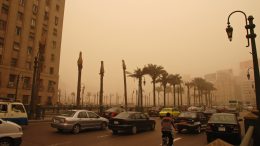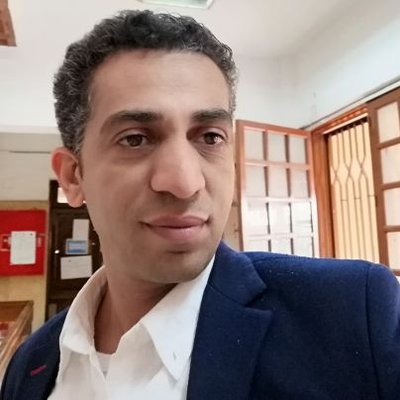In 2022 the Egyptian government announced its 100 Million Trees initiative, a plan in part intended to improve air quality in the capital city of Cairo and surrounding communities. So why, then, is Egypt still cutting down thousands of healthy trees?
According to information published by Egypt’s Central Agency for Public Mobilization and Statistics, the country needs approximately 58 million square meters of parks and green spaces to keep its air clean, yet currently only about 5.4 million square meters are available. Egypt lost 75% of its tree cover between 2010 and 2023, according to a recent study from the American University in Cairo.
And the problem keeps getting worse: Egypt has expanded construction of roads and buildings, and despite ongoing protests the government has destroyed many of its last green spaces to accomplish this. The loss of vital trees has made Cairo feel even hotter as climate change worsens. Citizens have been documenting the events with before-and-after photos to raise awareness of this environmental crime.
Egyptian Citizen:”The govt is systematically chopping down trees,bulldozing public gardens,+razing heritage sites,all for retail development. In my neighborhood, where all this is slated, they’re even building a concrete walkway in the middle of the Nile, an ecological disaster!” pic.twitter.com/Nm1MfRowZf
— Naomi Klein (@NaomiAKlein) November 9, 2022
Authoritarians Versus Trees
The tree-cutting phenomenon illustrates the authoritarian traits of Egypt’s political system: a lack of public participation in decision-making, weak oversight mechanisms, failed planning and governance, and the prevalence of class discrimination. The phenomenon signals a growing injustice and cruelly affects people, cities, and nature alike.
Authoritarian policies exacerbate social inequalities, favoring bureaucratic and capitalist interests, particularly as the construction and real estate sectors grow at the expense of the environment and green spaces. Rampant tree-cutting has become a recurring phenomenon, often on the pretext of road development, bridge construction, and waterway maintenance. But trees are even being cut down in areas not undergoing development, with no justification in terms of the public interest.
The assaults extend even to public parks, some of which hold historical significance, where portions are leased out for commercial purposes such as shops and kiosks. Local administrative bodies collect rental income by deeming unused land as ripe for “redevelopment.”
This behavior reflects a shortsighted and inadequate approach, aiming to fund government budgets, particularly in local districts. The conversion of green spaces is seen as an investment, treating trees as fertilizer, wood, or raw materials to be sold to manufacturers.
A Crisis of the Environment and Employment
Tree-cutting affects everyone but is especially hard on the poorest Egyptians. Every day Cairo receives an influx of people adding to its population of 10 million, driven by migration from nearby regions and governorates in search of work. The influx is exacerbated by high unemployment rates in rural areas of southern Egypt and the Delta, where the poorest populations reside. An estimated 29.7% of Egypt’s population of over 112 million lives below the poverty line.
Internal migration is on the rise as people flee dire social conditions and a lack of job opportunities, increasing population density in major cities. In Cairo car emissions rise and industrial activity expands unchecked, without consideration for sustainability or environmental regulations. Following the state’s abandonment of a planned economy and adoption of economic liberalization without a developed private sector capable of driving growth, a low-capital private sector, often the most polluting and employing the most exploited workers, has expanded.
Data indicates that Cairo’s air-pollution levels are extremely high. In Yale University’s 2024 Environmental Performance Index, Egypt ranked 122nd in the world for air quality. Some residents feel as though they’re struggling just to walk through the crowded streets during peak hours. A migrant worker who lost his job in agriculture and now commutes daily to the capital told me how he can smell Cairo both upon arriving and leaving during his daily 50-kilometer journey. The commute is considered preferable to unemployment, as his village has lost much of its greenery due to the shrinking agricultural sector, which once employed about a third of the population.
How We Got Here
During the 1950s President Abdel Nasser redistributed land owned by feudal landlords to the peasants. However, in the early 1990s, the land returned to large landowners through a law passed by President Hosni Mubarak. The descendants of these feudal landlords invested in land and abandoned agriculture in favor of real estate, contributing to the expansion of the construction sector in both villages and cities. Many viewed housing as a store of value, particularly with the depreciation of the Egyptian pound and the liberalization of exchange rates.
As a result of a complex set of historical stages, green spaces have dwindled, and tree-cutting has become a topic of debate over the past five years with Egypt facing unprecedented warming, rising pollution levels, and increased population density. I recently had a discussion with sociologist Hoda Badran, who was born in 1929 and has witnessed Egypt’s political shifts and urban transformation since the 1950s. She remarked: “I spent my childhood in the countryside of Qalyubia, a city close to the capital, surrounded by greenery. After graduating from university, I worked as a social worker in factories, where I saw development as being closely tied to environmental, social, and psychological elements that form an interconnected whole.”
Badran recalled that workers’ housing built by Nasser’s government included green spaces that have since vanished.
A Social Solution
Through Badran’s leadership roles in United Nations organizations, she came to understand the integral nature of development elements. “Greenery, a clean environment, and environmental awareness are developmental necessities and human rights,” she told me.
Reflecting on the 1990s, she remembered cofounding the National Council for Childhood and Motherhood in Egypt with Suzanne Mubarak, where environmental education was made a central component of its programs. The council worked on tree-planting initiatives with international and regional organizations, especially targeting children.
“Today there’s an awareness of climate change and the crime of cutting trees, but it’s not enough,” she tells me. “Environmental concerns must be at the heart of every policy and priority. Just as childhood issues are a priority within every priority, the environment must be a priority in every step and policy implemented in Egypt.”
She offers an example. “How can we ensure children’s health when they are exposed to respiratory diseases and poisoning due to pollution? Here the voices of the social sciences and environmental experts must be heard. Sociology connects the dots; it is a social medicine that diagnoses problems and influences policies. I believe that tree-cutting is a crime.”
An Investment Horizon
In December 2014 the Sadat City Authority announced the sale of 300 acres of forested land. According to Egypt’s Ministry of Environment, the country contains 8,000 acres of forest spread over 34 tree plantations in 17 governorates, all irrigated with wastewater. Therefore, tree-cutting cannot be justified under the pretext of water conservation, particularly in light of the Grand Ethiopian Renaissance Dam crisis, which threatens to reduce Egypt’s share of Nile River water.
Despite the dam crisis, green spaces, especially forests, could be expanded, which would mitigate the effects of severe climate change in Egypt. These forests could also provide jobs in the timber industry, where wood prices have skyrocketed. This has motivated corrupt forces to illegally harvest trees in a desperate bid for profit, as if they’re living in their final days. These groups are active in tree-harvesting, with occasional support from official voices.
In September 2022 Egypt’s Grand Mufti (a high religious office) justified tree-cutting as permissible “in the public interest.” Meanwhile other government officials admitted that mistakes had been made, claiming that the cutting was merely pruning — a term used as deception, similar to how prisons are called rehabilitation centers, power outages are termed load reduction, and floating the Egyptian pound and selling public assets are called economic reforms. Yet these so-called reforms often involve selling off national assets to pay down loans and debts, which have ballooned from $46.1 billion to $164 billion over the past decade.
Urban development plans fail to account for people’s rights to green spaces, with most official data (including government reports) showing that per capita green space has shrunk to less than one square meter, which is unevenly distributed. In contrast, the World Health Organization and the United Nations Environment Programme recommend that green spaces should not fall below nine square meters per person. Yet the authorities continue to ignore the importance of green spaces in reducing both noise and air pollution, the latter exacerbated by rising fossil fuel consumption, which contributes to health problems, especially respiratory diseases. And cities suffering from overcrowding and pollution, as Egypt’s are, are highly vulnerable to the impacts of climate change, particularly heatwaves.
View this post on Instagram
Neither the environment nor the people seem to matter to a government obsessed with accumulating wealth through geographic redevelopment and economic exploitation. Bureaucracy and state policies view everything — people, land, and natural resources — as opportunities for profit, without regard for long-term consequences.
The current trajectory of urban development benefits certain classes who profit from desertification and the ongoing tree-cutting phenomenon. In some cases plastic trees replace real ones, adding a touch of irony and sadness. Large amounts of artificial turf (landscape) are supplied directly to government agencies, where economic interests intersect with cruelty and deception, forming a triangle of power.
A Heartless City
Poet Abdel-Moati Hegazy described Cairo as a “city without a heart” in his 1959 collection, and again in his 1989 book Trees of Cement, in which he lamented, “This cement tree stretches everywhere / Writhing like devils / Catching birds that fall like stones / Into radar devices.”
At the time Hegazy wrote these lines, Cairo was far less environmentally and architecturally degraded than it is now, with a smaller population and a more visible role for the state in maintaining greenery. Class disparities in urbanization and access to green spaces were also less pronounced, and tree-cutting crimes were not as pervasive or heavily justified by state propaganda, as they are today, where reasons range from facilitating security surveillance to bridge construction, most of which involve steel structures that lack aesthetic value and feel more like wartime fortifications.
A System That Cuts Trees and Claims to Fight Climate Change
While the government cuts down trees, it simultaneously engages in a publicity campaign about combating climate change, aiming to secure $100 billion in funding by 2030. Part of this money has already been secured through green investments and grants for large-scale, important projects — though some have stalled.
In May 2023 the government offered for sale shares in three large electricity production plants, including clean energy facilities, at a time when the country was grappling with an energy crisis. It has also constructed some areas that meet international housing standards, in collaboration with international partners (with plans to build 14 smart cities). But these remain limited, expensive, and largely accessible to foreigners and the wealthy.
Many climate-related projects have an air of showmanship. The Ministry of Environment launched the “ECO EGYPT” campaign to promote tourism, as part of the presidential initiative “Prepare for Green.” The project was initially designed by Egyptian graphic designer Ghada Wali and funded by the UN Development Programme and the Global Environment Facility. However, the project’s official website collapsed, along with Wali’s promotional materials, after she was accused of plagiarizing artwork for another project — the metro beautification initiative. This scandal reflects corruption under the guise of climate action.
The scandal illustrates the level of propaganda surrounding climate issues and highlights how profiteering circles extend beyond the government to other sectors, proving that the rhetoric about addressing climate change is superficial.
A Crisis of Green Space — and of Government
Egypt is facing a multifaceted crisis that stems from the nature of its authoritarian regime, which considers neither sustainable urban planning nor the rights of its citizens. Lacking an active parliament or local councils (which haven’t been elected since 2008), the government remains disconnected from its people, rendering environmental justice and social equity unattainable.
Ultimately authoritarian regimes often use environmental issues for propaganda purposes while failing to address them effectively. Their policies on reducing green spaces worsen environmental destruction, much as colonial and military regimes prioritize private interests over the well-being of indigenous populations.

Previously in The Revelator:
Warming Cities, Dying Trees: Can We Keep Our Cities’ Tree-lined Streets?




